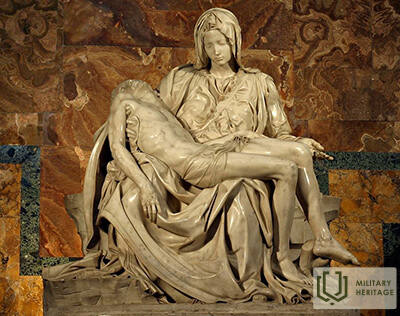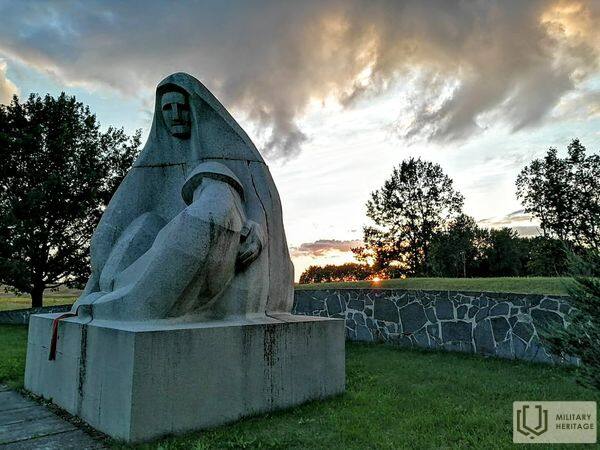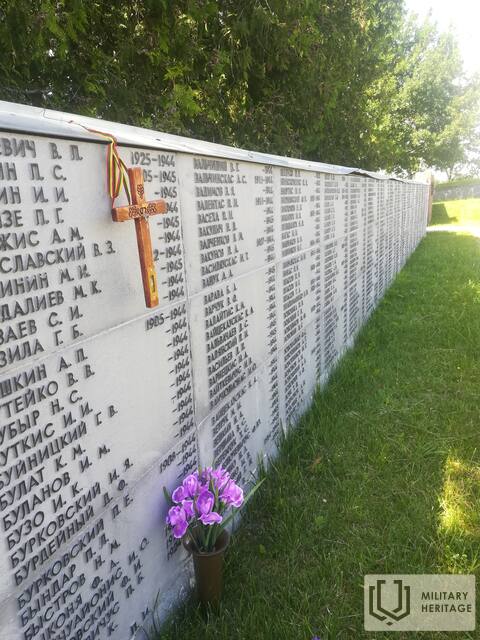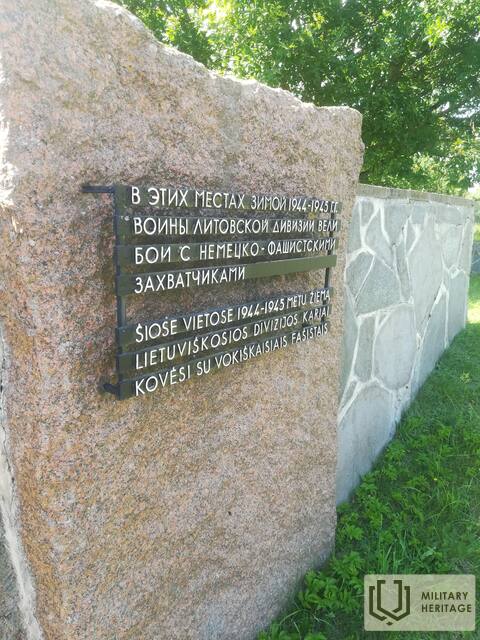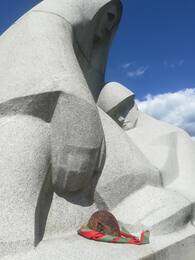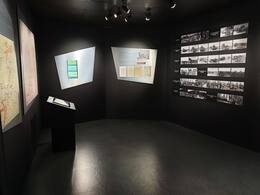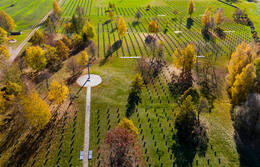Pieta arba „Mamos“ memorialinis ansamblis Nīkrace
Pieta, arba Mamytė, yra gerai žinomas motyvas Europos kultūroje ir mene, jis buvo naudojamas ir sovietmečiu.
Nykrācės paminklas dar vadinamas „mumija“. Paminklą 1979 m. sukūrė skulptorė L. Rezevska.
Kodėl ji vadinama PIETA? – „Pieta“ yra italų menininko Mikelandželo renesanso skulptūra, esanti Šv. Petro bazilikoje Vatikane. Tai vienintelis Mikelandželo pasirašytas kūrinys.
Susijusi laiko juosta
Susijusios vietos
Raudonosios armijos karių memorialinė vieta „Pieta“ Nykracės savivaldybėje
Sovietinių karių kapinės yra Skrundos–Embutės–Priekulės kelyje, aukštumoje tarp dviejų upių – Dzeldos pietuose ir Kojos šiaurėje. Jose palaidota daugiau nei 3000 žuvusiųjų.
Antrojo pasaulinio karo mūšiai
Raudonoji armija pradėjo puolimo operaciją nuo 1944 m. spalio 27 d., dabar žinomą kaip 1-asis Kurlando batalionas, kurios tikslas buvo sunaikinti vokiečių armijų grupę „Šiaurė“, vėliau pervadintą „Kurlandu“. Iki lapkričio 5 d. sovietų 61-oji armija ir dalys 6-osios gvardijos armijos bei 4-osios smūginės armijos pasiekė Zeldo upę, o kai kurie 5-osios gvardijos tankų armijos daliniai užėmė tiltų galvutes šiauriniame upės krante. Prieš kitą puolimą 1-ojo Baltijos fronto 2-oji gvardijos armija buvo perkelta į šį sektorių, kad pasiektų Skrundos-Liepojos geležinkelio liniją. Įvykdžius pradinę invaziją, puolimą Kuldygos link tęsė 5-oji gvardijos tankų armija.
Antrojo Kuršo mūšio pradžią atidėjo oro sąlygos ir jis prasidėjo tik lapkričio 19 d. Didžiausius pasiekimus Raudonoji armija pasiekė netoli dabartinių Brolių kapinių, o iki lapkričio 24 d. vakaro 1-asis ir 60-asis šaulių korpusai užėmė plakadarmą šiauriniame Koj upės krante. Tačiau Raudonosios armijos sėkmė tuo ir baigėsi. Vokiečių armijų grupė „Šiaurė“ numatė sovietų atakų kryptį ir čia sutelkė atitinkamas pajėgas, įskaitant dvi tankų divizijas.
1944 m. lapkričio 26 d. vakarą Raudonosios armijos atakos buvo sustabdytos ir iki Antrojo pasaulinio karo pabaigos nebuvo bandoma sunaikinti vokiečių pajėgų Kurše. Vėlesniuose mūšiuose buvo siekiama užkirsti kelią vokiečių armijos evakuacijai iš Kuršo.
Ezerės kraštotyros saugykla „Muitas Nams“
Ezerės muitinė yra Ezerėje, netoli Saldaus-Mažeikių plento, Latvijos ir Lietuvos pasienyje. 1945 m. gegužės 8 d. šiame pastate buvo pasirašytas vadinamojoje „Kuršo kišenėje“ apsuptų Vokietijos armijos dalinių „Kurzeme“ (Kurlandas) kapituliacijos aktas. Manoma, kad Antrasis pasaulinis karas iš tikrųjų baigėsi Ezerėje. Muitinėje yra ekspozicija, kurioje aprašomi Antrojo pasaulinio karo pabaigos įvykiai, ir eksponatai, kuriuose išsamiai aprašoma Ezerės parapijos istorija nuo seniausių laikų iki šių dienų. 1945 m. gegužės 7 d. rytą Leningrado fronto vadas maršalas L. Govorovas išsiuntė armijų grupės „Kurzeme“ vadovybei ultimatumą sudėti ginklus. Kapituliacijos aktą susijusios šalys pasirašė gegužės 8 d., jame išsamiai aprašyta perdavimo tvarka, ginklų surinkimo punktai, pateiktini dokumentai ir informacija bei kitos praktinės priemonės.
Saldaus vokiečių kareivių kapinės
Saldaus vokiečių kareivių kapinės yra prie Saldaus–Ežerės plento. Kapinėse, užimančiose 8 hektarų plotą, yra apie 25 000 vokiečių kareivių, taip pat kai kurių Latvijos legionierių palaikai. Perlaidojimai vyksta nuo 1997 m.
Nuo gegužės 1 d. iki spalio 1 d. memorialiniame kambaryje galima apžiūrėti parodą apie Kuršo mūšius. Šiuo laikotarpiu memorialinis kambarys dirba darbo dienomis nuo 9:00 iki 17:00 val., o šeštadieniais ir sekmadieniais kapinėse dirba ir gidas. Taip pat galima susipažinti su Saldaus vokiečių kareivių kapinėse palaidotų ir visoje Latvijoje žuvusių kareivių sąrašais.




